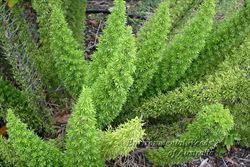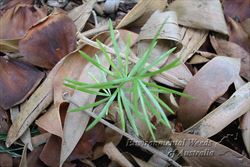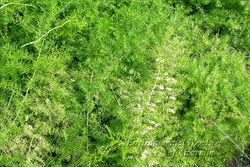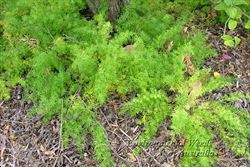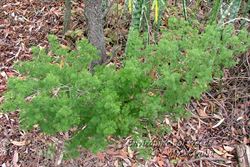Synonyms
Asparagus aethiopicus L.Asparagopsis densiflora KunthAsparagus densiflorus (Kunth) JessopAsparagus myriocladus BakerAsparagus sarmentosus L.Asparagus sprengeri RegelProtasparagus aethiopicus (L.) Oberm.Protasparagus densiflorus (Kunth) Oberm.
Family
Asparagaceae (Queensland, New South Wales, the ACT and Western Australia)Liliaceae (Victoria, Tasmania, South Australia and the Northern Territory)
Common Names
asparagus fern, basket asparagus, basket asparagus fern, bushy asparagus, emerald asparagus fern, emerald feather, fern asparagus, ground asparagus, ground asparagus fern, ground fern, protasparagus, regal fern, smilax, Sprenger asparagus, Sprengeri fern, Sprenger's asparagus, Sprenger's asparagus fern, Sprenger's asparagus-fern
Origin
Native to a small region in southern Africa (i.e. Cape Province of South Africa). This species was previously known as Asparagus densiflorus in Australia, but that is now considered to be a separate African species not yet introduced here.
Cultivation
Ground asparagus fern (Asparagus aethiopicus 'Sprengeri') is widely cultivated as a garden plant, particularly in eastern Australia. Forms of this plant with variegated 'leaves' are also present in cultivation. Another cultivar, known as foxtail asparagus fern (Asparagus aethiopicus 'Meyersii'), has also been widely cultivated in Australia.
Naturalised Distribution
This species is widely naturalised in the coastal districts of eastern Australia. It is very common in the coastal districts of south-eastern Queensland, relatively common in the coastal areas of northern New South Wales, and less common in the coastal districts of central and southern New South Wales. It has also been recorded in Victoria, south-western Western Australia, south-eastern South Australia, on Norfolk Island and on Lord Howe Island.
Also naturalised overseas in Hawaii, southern USA (i.e. Florida and California) and New Zealand.
Habitat
A weed of coastal sand dunes, riparian areas, open woodlands, rainforests and forest margins in sub-tropical, warmer temperate and tropical regions. It prefers sandy soils and usually also some shade, and is occasionally also seen in parks, old gardens and disturbed sites.
Habit
A long-lived (i.e. perennial), low-growing, herb with spreading (i.e. erect to sprawling) or arching stems (up to 2 m long) that arise from a tuberous rootstock. When growing up over other vegetation it can sometimes also climb up to 2 m in height.
Distinguishing Features
- a low-growing herbaceous plant with creeping underground stems and tubers as well as sprawling or arching aboveground stems.
- the aboveground stems have some short spines and bear numerous small 'leaves' that give them a ferny appearance.
- these narrow 'leaves' (15-25 mm long and 2-3 mm wide) are clustered together in groups of one to eight along the stems.
- its small white or pinkish flowers are borne in elongated clusters.
- its fruit are glossy berries (5-8 mm across) that turn from green to red as they mature.
Stems and Leaves
This species produces creeping underground stems (i.e. rhizomes) and tubers as well as its aboveground stems. The sprawling or arching aboveground stems (mostly 30-100 cm long, but occasionally up to 2 m long) are green to brownish in colour and somewhat rounded, but ridged lengthwise (i.e. longitudinally). Many small branches (up to 10 cm long) and short spines (5-10 mm long) grow outwards from these main stems.
The true leaves are reduced to scales and what appear to be the 'leaves' are, in fact, small flattened stems which function as leaves (i.e. cladodes). One to eight of these slightly flattened and slender (i.e. linear) 'leaves' (15-25 mm long and 2-3 mm wide) are clustered together in the forks (i.e. axils) above each tiny scale leaf. They are hairless (i.e. glabrous) and usually pale green in colour.
Flowers and Fruit
The flowers are borne on short stalks (i.e. pedicels) 4-10 mm long and are arranged in relatively dense elongated clusters (i.e. racemes), 2-10 cm long, in the forks (i.e. axils) of some of the the tiny scale leaves. These flowers are white to pinkish in colour with three sepals and three petals (3-5 mm long) that are very similar in appearance (i.e. the flowers actually have six perianth segments, or tepals, but appear to have six petals). Flowering occurs from spring through to early autumn.
The fruit is a rounded (i.e. spherical) berry (5-8 mm across) and usually contains a single black seed (3-4 mm across). These glossy berries are initially green in colour, but turn red as they mature. Fruit may be present throughout the year.
Reproduction and Dispersal
This species reproduces by seed and also vegetatively via its creeping underground stems (i.e. rhizomes) and tubers.
Its berries are readily eaten by birds and the seed contained within are thereby spread to new areas. Its seeds and underground tubers are also commonly dispersed in dumped garden waste.
Environmental Impact
Ground asparagus fern (Asparagus aethiopicus 'Sprengeri') is a significant environmental weed in Queensland and New South Wales, and an emerging environmental weed in Victoria, South Australia and Western Australia. It is actively managed by community groups in Queensland and is currently listed as a priority environmental weed in five Natural Resource Management regions. Ground asparagus (Asparagus aethiopicus 'Sprengeri') forms a thick mat of tuberous roots and grows particularly well in shaded areas and in sandy soils. It is most prevalent in coastal environs, but has also invaded littoral rainforests, rainforest margins, sclerophyll forests, urban bushland and heathlands. The dense growth of this species may form impenetrable thickets that smother native understorey plants and inhibit their regeneration, thereby transforming the ground layer of native plant communities.
In south-eastern Queensland Ground asparagus (Asparagus aethiopicus 'Sprengeri') is ranked among the top 25 most invasive plant species and is one of the most significant garden escapes invading coastal habitats. For example, it is one of the top 10 weeds in the Gold Coast local government area, with heavy infestations present in Burleigh Heads National Park near the Queensland-New South Wales border. In New South Wales it is also extensively naturalised in coastal districts, especially in the Sydney region, and is a serious weed threat to bushland north from Sussex Inlet. In some places it has become the dominant ground layer plant, even displacing native plants in undisturbed communities. It has also been reported from coastal sand dunes in south-western Western Australia.
Scientific Name
Asparagus aethiopicus L. 'Sprengeri'
Legislation
This species is declared under legislation in the following states and territories:
- New South Wales: Class 4 - a locally controlled weed. The growth and spread of this species must be controlled according to the measures specified in a management plan published by the local control authority and the plant may not be sold, propagated or knowingly distributed (in the Blue Mountains, Hunters Hill, Hornsby, Ku-ring-gai, Lane Cove, Lord Howe Island, Manly, Mosman, North Sydney, Parramatta, Pittwater, Ryde, Warringah and Willoughby local authority areas).
- Queensland: Class 3 - this species is primarily an environmental weed and a pest control notice may be issued for land that is, or is adjacent to, an environmentally significant area (throughout the entire state). It is also illegal to sell a declared plant or its seed in this state.
- Western Australia: Unassessed - this species is declared in other states or territories and is prohibited until assessed via a weed risk assessment (throughout the entire state).
Management
For information on the management of this species see the following resources:
- the Biosecurity Queensland Fact Sheet on this species, which is available online at http://www.dpi.qld.gov.au.
- Section 5 of the Asparagus Weeds Best Practice Management Manual, which is available online at http://www.weeds.org.au/WoNS/bridalcreeper/docs/Asparagus_Weeds_BPMM-5.pdf.
Similar Species
Ground asparagus fern (Asparagus aethiopicus 'Sprengeri') is similar to the climbing asparagus ferns (Asparagus africanus and Asparagus plumosus), bridal veil (Asparagus declinatus), bridal creeper (Asparagus asparagoides), garden asparagus (Asparagus officinalis), sicklethorn (Asparagus falcatus), Ming asparagus fern (Aspargaus retrofractus) and other asparagus ferns (Asparagus scandens and Asparagus virgatus). These species can be distinguished by the following differences:
- ground asparagus fern (Asparagus aethiopicus 'Sprengeri') is usually a low-growing or scrambling plant with spreading or drooping branches bearing some small sharp thorns. Its 'leaves' (i.e. cladodes) are borne in groups of one to eight (usually 2-5) along the stems, are linear in shape, and are moderately large (15-25 mm long and 2-3 mm wide). Its flowers are borne in elongated, many-flowered clusters (i.e. racemes) and its fruit turn red when mature.
- climbing asparagus fern (Asparagus africanus) is a climbing plant with long-lived and thorny main stems. Its 'leaves' (i.e. cladodes) are borne in groups of more than three along the stems, are linear in shape, and are relatively small (6-15 mm long and only about 0.5 mm wide). Its flowers are borne in small several-flowered clusters and its fruit turn orange when mature.
- climbing asparagus fern (Asparagus plumosus) is a climbing plant with long-lived and thornless or slightly thorny main stems. Its 'leaves' (i.e. cladodes) are borne in groups of more than three along the stems, are linear in shape, and are very small (4-7 mm long and only about 0.5 mm wide). Its flowers are borne singly or in pairs and its fruit turn black when mature.
- bridal veil (Asparagus declinatus) is a creeping or climbing plant with short-lived thornless stems that die back each summer. Its 'leaves' (i.e. cladodes) are borne in groups of three along the stems, are linear in shape, and are relatively small (5-20 mm long and 0.5-1.5 mm wide). Its flowers are borne singly and its fruit turn bluish-grey or whitish in colour when mature.
- bridal creeper (Asparagus asparagoides) is a creeping or climbing plant with short-lived thornless stems that die back each summer. Its 'leaves' (i.e. cladodes) are borne singly along the stems, are oval (i.e. elliptic) in shape, and are relatively large (10-70 mm long and 10-30 mm wide). Its flowers are borne singly or in few-flowered clusters and its fruit turn red when mature.
- garden asparagus (Asparagus officinalis) is an upright plant (up to 2 m tall) with short-lived thornless stems that die back each summer. Its 'leaves' (i.e. cladodes) are borne in groups of one to five along the stems, are linear in shape, and are relatively small (12-25 mm long and 0.5 mm wide). Its flowers are borne singly or in pairs and its fruit turn red when mature.
- sicklethorn (Asparagus falcatus) is a shrubby climbing plant with long-lived and thorny main stems. Its 'leaves' (i.e. cladodes) are borne in groups of three to six along the stems, are elongated in shape, and are quite large (35-125 mm long and 2-5 mm wide). Its flowers are borne in elongated, many-flowered clusters (i.e. racemes) and its fruit turn red or whitish when mature.
- Ming asparagus fern (Aspargaus retrofractus) is shrubby plant with somewhat woody branches bearing some small sharp thorns. Its 'leaves' (i.e. cladodes) are borne in large clusters along the stems, are linear in shape, and are moderately large (12-25 mm long and only about 0.5 mm wide). Its flowers are borne in large rounded clusters and its fruit turn black when mature.
- asparagus fern (Asparagus scandens) is a creeping or climbing plant with short-lived or long-lived thornless stems. Its 'leaves' (i.e. cladodes) are borne in groups of three along the stems, are linear in shape (often slightly curved), and are relatively small (5-15 mm long and 0.5-1.5 mm wide). Its flowers are borne singly or in few-flowered clusters and its fruit turn orange or red when mature.
- asparagus fern (Asparagus virgatus) is an upright plant (up to 1.5 m tall) with short-lived or long-lived thornless stems. Its 'leaves' (i.e. cladodes) are borne in groups of three along the stems, are linear in shape, and are relatively small (6-20 mm long and 0.5-1 mm wide). Its flowers are borne singly and its fruit turn orange when mature.
There is another form of ground asparagus fern (Asparagus aethiopicus) that is also commonly cultivated in Australia, the foxtail asparagus fern (Asparagus aethiopicus 'Meyersii'). This plant has not yet become widely naturalised in Australia. Foxtail asparagus fern (Asparagus aethiopicus 'Meyersii') can be distinguished from ground asparagus fern (Asparagus aethiopicus 'Sprengeri') by its upright or spreading branches that are almost cylindrical in appearance with densely clustered foliage.

